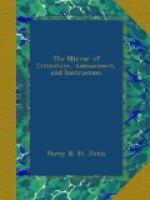To many of the Dials were suitable inscriptions as above, and these with the references must have made the construction of the whole a task of immense labour. It would be absurd to expect that Charles II. had much to do with its completion, for he was, in his own estimation, more pleasantly employed than in watching the flight of time by heavenly luminaries. His attractions were on earth, where the splendour of a wicked court and the witchery of bright eyes eclipsed all other pursuits. Still, the licentious king was not forgotten by the inventer of the dial. Among the pictures on some of the glasses were portraits of the king, the two queens, the duke of York, prince Rupert, &c. In the king’s picture, the hour was shown by the shade of the hour-lines passing over the top of the sceptre—perhaps the only time the royal trifier ever pointed to so useful an end. Prince Rupert, by his contributions to science, had a better right to be there; but Charles was not even grateful enough for the elevation to protect the precious Dial from rain and snow.
In the list of subscribers for the reprint of the Tract, occurs “Jacob Chandler, basket-maker:” in our times this would be considered a knotty work for any but a professional reader.
* * * * *
NOTES OF A READER
* * * * *
HISTORY OF INSECTS.
The Family Library, No. 7. Library of Entertaining Knowledge, Part 6.—Insect Architecture.
At present we can only notice these works as two of the most delightful volumes that have for some time fallen into our hands, and as possessing all the merits which characterize the previous portions of the Series. Our cognizance of them, in a collected form, must rest till the other half appears; in the meantime a few flying extracts will prove amusing:—
Bees without a Queen.
These humble creatures cherish their queen, feed her, and provide for her wants. They live only in her life, and die when she is taken away. Her absence deprives them of no organ, paralyzes no limb, yet in every case they neglect all their duties for twenty-four hours. They receive no stranger queen before the expiration of that time; and if deprived of the cherished object altogether, they refuse food, and quickly perish. What, it may be asked, is the physical cause of such devotion? What are the bonds that chain the little creature to its cell, and force it to prefer death, to the flowers and the sunshine that invite it to come forth and live? This is not a solitary instance, in which the Almighty has made virtues, apparently almost unattainable by us, natural to animals! For while man has marked, with that praise which great and rare good actions merit, those few instances in which one human being has given up his own life for another—the dog, who daily sacrifices himself for his master, has scarcely found an historian to record his common virtue.—Family Library.




